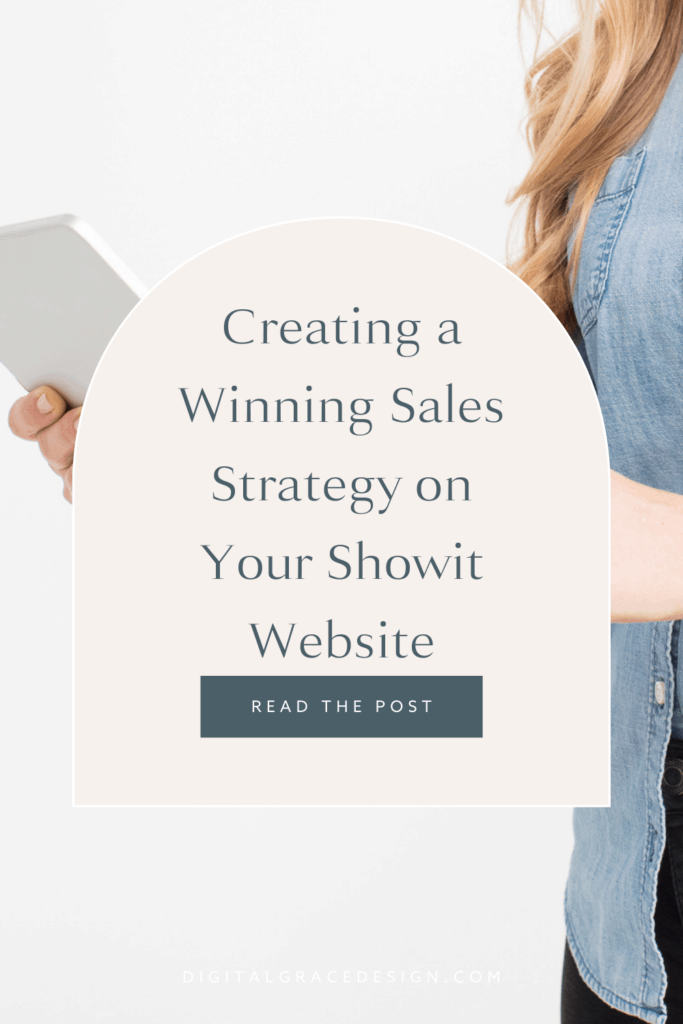How do you feel about selling?
When I asked that question, did you anxiously bite your nails or feel like running in the other direction? You’re not alone! Many creative entrepreneurs avoid talking about sales and money because they’d rather focus on storytelling and building memorable client experiences.
Let’s face it: We need to make sales in order to stay in business. However, we can change the way we sell so it feels genuine rather than salesy. That way, the numbers behind your business don’t feel scary.
I want to help you build a website sales strategy that doesn’t feel anxiety-inducing or overly competitive.
In this article, I’m going to walk you through the five stages of a strong sales strategy. Once you understand each step, you’ll be able to create your own sales funnel and incorporate it into your Showit website.
Let’s begin!
The five key stages of your website sales strategy
No matter if you sell services or products, think about how you want to lead potential customers to your core offers. How can you strategically guide them and give them the information they need to feel confident in making a purchase? This process is what we call a sales strategy.
By fully mapping out your customer’s journey, you’ll be able to understand what steps they need to take before you can earn their sale.
Once they complete the journey, each potential customer will be given a choice.
Do they want to make a purchase from you or continue exploring other options?
Of course, as business owners, our hope is to attract people who are ready and willing to buy our offers. However, we need to give them the right information and education before we can expect them to purchase our products or services.
Keep in mind that most people won’t take action the first time you ask them to. In fact, customers need to hear a message seven times before they consider acting upon it.
Being repetitive is actually a good thing. If you feel like you’re nagging or annoying your audience by posting multiple pieces of content, you can rest easy knowing that only a percentage of your audience will see and read each message. That’s why it’s best to create fresh content with similar messaging but written from different angles so you’re always adding something new to the conversation.
If I had a nickel for every time an entrepreneur told me they didn’t hit their launch sales goals but only posted on social media a couple of times. It happens frequently, but when you have a more well-rounded website sales strategy, it will do much of the selling for you.
Without further ado, let’s dive into the five stages of your website sales strategy:
- Attract
- Build
- Nurture
- Invite
- Grow
If you follow all of these steps, you’ll be closer to raising your website conversions and making more sales. I’ll use the rest of this article to explain each stage and walk you through a real example from my own business to inspire your own strategy.
Let’s go behind-the-scenes to see how I sell my course, Simple Showit SEO, and how you can take the same principles to sell your main offers.
Attract
Instead of jumping right into sales, we’ll focus on marketing first! The initial stage of your sales strategy will be about attracting new audience members. In order to generate more sales, you need more people who know about your brand.
Small business owners usually like this stage of marketing because it allows them to be creative and interact with new potential customers. While it’s important to capture your audience’s attention, you’ll want to use your efforts to attract the right people.
This is easier to do when you’ve already defined your ideal client avatar (ICA), which can also be called your ideal client profile or ideal client description. Your ICA begins with the demographics of your ideal client. Knowing their gender, age range, location, income level, and education level can be helpful in better understanding who they are.
However, you’ll want to go deeper by uncovering their psychographics. This means you’ll define their unique characteristics, traits, strengths, weaknesses, interests, habits, and motivations, to name a few. While the demographics give you a great foundation, these psychographics will unlock new discoveries you’ll need in order to market your offers to the right people.
When you know who you’re talking to and who you want to create content for, the next step is determining which platforms are right for you. First, identify where your ideal clients already hang out. It’s easier to meet them where they are than trying to convince them to meet you on another platform they’re not familiar with.
Here are a few ideas for attracting your audience:
Post educational content on social media
When you give your audience tons of value upfront, they’ll be convinced that your paid products or services will go above and beyond! It’s smart to use social media platforms to educate your audience on subjects you’re an expert in. It’s even better if they relate to your signature offers!
Take this Instagram post from me, for example. I put together a 10-point website checklist to help my audience members audit their own websites. All of these recommendations will help to improve someone’s SEO, making it a relevant fit with my course. You can do the same thing by breaking down one of the core topics of your own niche.
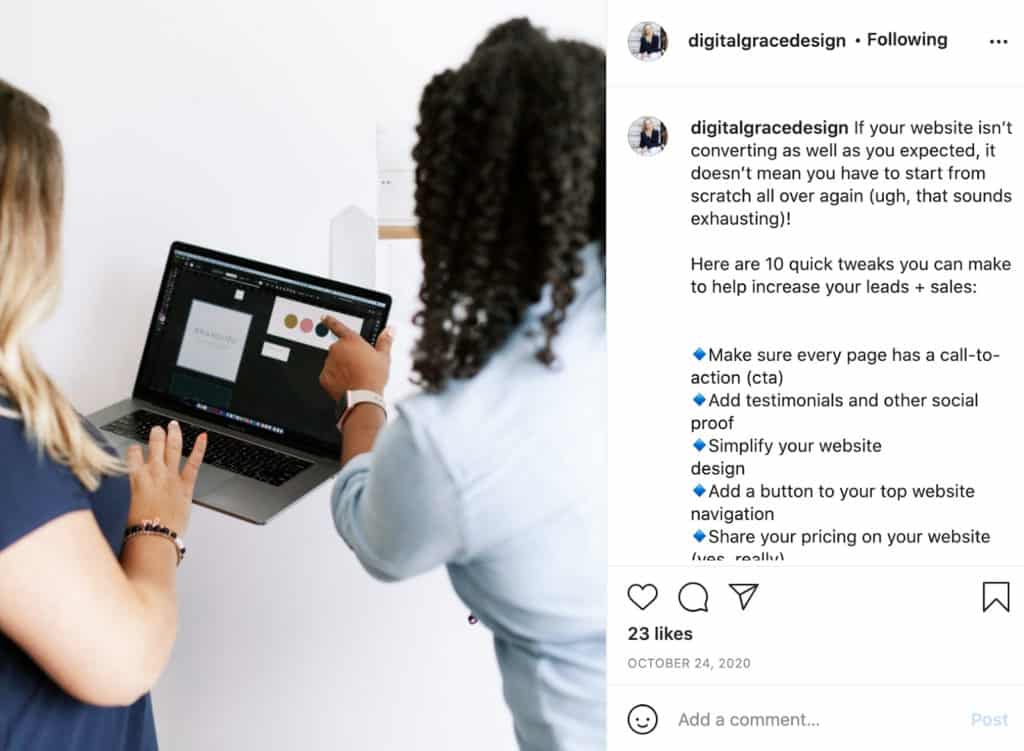
Consistently publish helpful blog posts
One of the best ways to attract a new audience is by writing regular content on your blog. When you have a strong archive of educational articles, you’ll be able to share more tips and advice with your potential customers.
This freely available content will help new readers build trust with your brand. If you optimize your blog posts for SEO, you’ll increase the likelihood of the right people finding you even more!
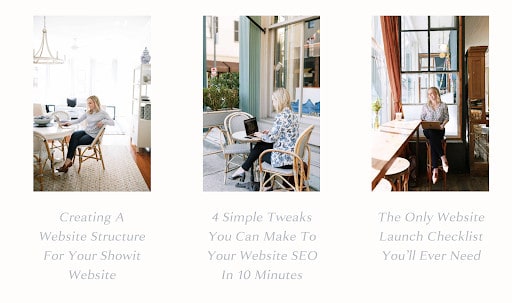
Weave it into your podcast interviews
No matter if someone asks to interview you on their podcast or you pitch yourself (go for it!), think about how you can weave your subject matter expertise into your episode. Many podcast hosts will be open to your ideas, so get creative with this and add as much value as you can.
When I was interviewed on the Mike Cassidy Photography podcast, I chose to talk about SEO. Mike gave me the opportunity to connect with his audience of wedding photographers, which falls underneath my own ICA. He even let me plug my Simple Showit SEO course toward the end, so it was a win-win for both of us!
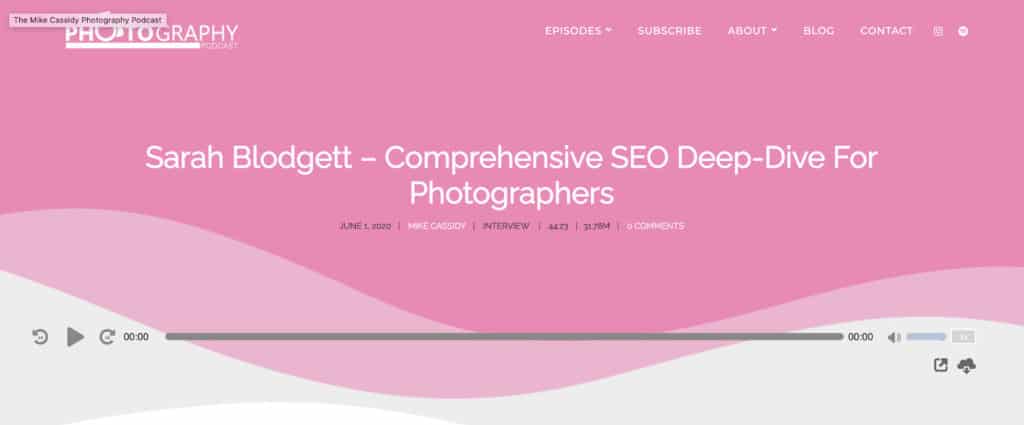
Build
Once you have the attention of your audience, you’ll want to do something with it! At this stage, you’ve already given them helpful content and they’re ready to take the next step. It’s time to build your audience by asking them to join your email list.
Why an email list, you may ask? Well, it’s the only platform (besides your website) that you truly own. It’s better to grow your audience through email marketing than social media or other content platforms.
On average, for every dollar spent on email marketing, $38 are earned in return. That’s higher than any other kind of marketing, so it’s worth paying attention to!
If you haven’t started an email list yet, I highly recommend using Flodesk. They have beautifully designed email templates and don’t charge you extra frees as you grow your list of subscribers. Click here to get 50% off for the lifetime of your account so it’s only $19/month!
Once you’ve created your email list, you’ll need to find ways to convince your social media followers to join. Here are a few things that have worked for me.
Create a lead magnet
A lead magnet is simply a freebie or downloadable that you can offer your audience free of charge. Many bloggers and business owners use lead magnets to grow their list because it gives their audience upfront value before they spend a dime.
Lead magnets are also a powerful way to build trust with your audience as you teach them about a topic you’re an expert in. When you’re seen as a trusted expert, you’ll find it easier to increase your conversions.
Some of the most common lead magnets include:
- Templates
- eBooks
- Email courses
- Worksheets
- Workbooks
- Evergreen webinars
- Video series
There are dozens of lead magnet ideas you can experiment with, but I decided to go with a Showit SEO Checklist in a PDF format. When someone downloads this checklist by entering their email address, they will immediately receive it along with instructions on how to use it to improve their SEO.
If someone signs up for this checklist, they’re probably going to be more likely to buy my SEO-themed course than someone who isn’t concerned with their SEO performance.
After creating this lead magnet, I designed a variety of social media graphics to entice more people to sign up (see below). You can do the same with yours!
Qualify leads with a quiz
One of my favorite types of lead magnets is interactive quizzes. By asking your audience a series of intentional questions in a quiz, you’ll be able to gather data while also giving them helpful quiz results.
You can create a personality-based quiz or an assessment quiz that helps your audience answer a specific question. It’s even possible to use your quiz to recommend different products from your shop! I personally use Interact, a free quiz builder, to create my quizzes and really recommend it. You can learn more about it by clicking here and start building your own!
I have two quizzes on my website at the moment. One quiz helps my audience understand whether they should invest in a custom website or Showit template, which relates to my Showit design services.

The other quiz gives my audience a specific website platform recommendation based on their needs. This relates to my services as well, but also to my Simple Showit SEO course. It weeds out the people who aren’t a good fit for Showit so I can spend my time connecting with clients who want to build a website in the same platform I work in.
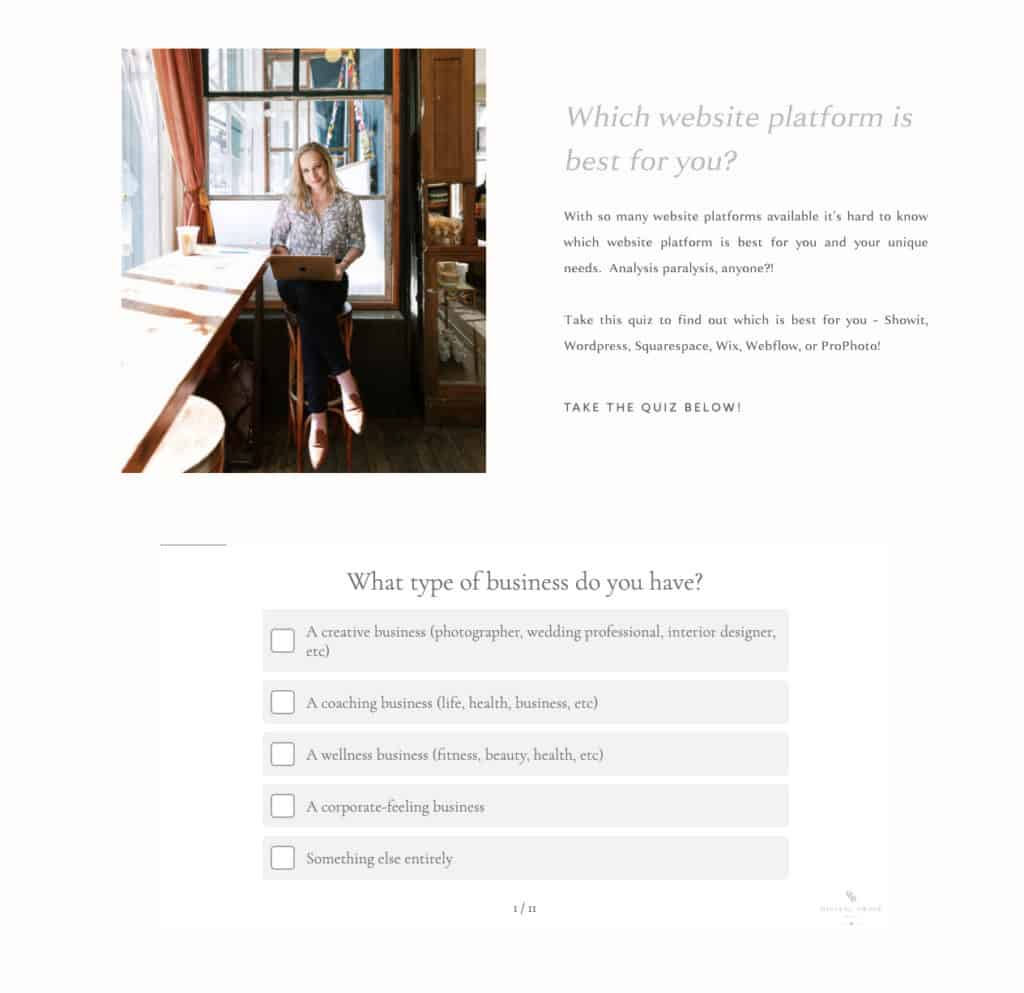
While the SEO tips I share in my course can be used for other platforms, I spend a lot of time walking students through the steps of updating their SEO inside Showit. It’s the most relevant fit for them.
Once someone takes my quiz, they’ll have the opportunity to join my email list as they review their quiz results. You can do the same with your quiz, which will help you grow your email list in an easy and automated way.
Nurture
In this next stage, your job is to nurture the audience members that have joined your email list. Take a moment to welcome them into your community and tell them a little about yourself. People love getting to know the people (or person) behind a brand, so this gives you an incredible opportunity to build your relationship with each new email subscriber.
Create a welcome email sequence
A welcome email sequence features a series of emails you’ll automatically send to your audience after they sign up for your list. Did you know sending welcome emails can increase your revenue by 51% on average? Now I’ve got your attention!
It’s important to have welcome emails in place when someone signs up for your list. Think about how boring it would be to hear crickets after signing up. After a few weeks of silence, an audience member will likely forget about your brand if you’re not sending follow-up emails. We don’t want that!
Your welcome email sequence can be as simple or robust as you’d like. Some brands have three emails in their sequence while others have over ten. There’s no right or wrong way to put it together, but if you need a framework to follow, you can take a peek inside my own strategies here.
Each email will introduce your brand, clarify who you are and what you offer, show how you can help them, and give them solutions to their most common challenges. You can do this in multiple ways, so feel free to get creative.
While your audience will move from this stage to the next, you’ll want to continue creating this nurturing content for your audience. It’s best to set expectations early for how often they’ll hear from you and what topics you’ll write about. When you send consistent emails, you’ll see your open rates and click rates increase over time.
Invite
As you’ve nurtured your audience, it’s time to introduce your product or service. This means you’re entering the sales stage, but I like to call it the “invite” stage.
For some creatives, it feels better to invite someone into what you’re offering than simply selling something. We’ll use the terms interchangeably here, but if you still don’t like the word “sales,” looking at it from this perspective may help you.
Write better sales copy
One of the first places where you’ll invite your audience to check out your offer is on your sales page. While your design and visuals are clearly important, you can’t skip over your messaging. You can either hire a copywriter if you don’t have the time, energy, skills, or interest in this project, or try to DIY your own sales copy.
When you’re in this stage, it’ll be important for you to explain not only the features inside your offer but, more importantly, its benefits. For example, a feature of your product might be the number of training videos or worksheet pages that are included. However, a benefit is that it will help your audience achieve one of their ideal goals, like increasing their revenue or improving their health.
If you explore my course sales page, you’ll notice that I introduce the benefits before I talk about the features. This is done intentionally to connect with my potential customers and guide them through the rest of my sales page.
In addition to breaking down what’s included in your offer, you’ll also want to include testimonials from other people who have worked with you or benefited from your product. Social proof can improve your conversions because 61% of customers read online reviews before choosing to buy a product or service.

If you want to take it one step further, you can also ask past clients or customers to give you video testimonials. These are powerful because potential customers will be able to hear a past customer’s experience in their own words while having a visual of who they are. If someone is willing to you in this way, it shows you are worthy of their trust.

Post launch-based content on social media and through email
In addition to creating a great sales page, you’ll also want to tell your social media followers and email subscribers about your offer. If you plan to launch your offer rather than having it available as an evergreen product or service, it’s a great idea to create a series of messages you can repurpose for social media and email marketing.
Here’s an inside look into how I did this for the last launch of my course:
- Post 1: Announced the reopening of my course (posted a week before)
- Post 2: Officially opened my course for enrollment (posted the day of)
- Post 3: Highlighted testimonials from past students (posted during launch week)
- Post 4: Reminded my followers that the cart was closing soon (posted on the last day)
If I wanted to email my list with similar content, I could take these same posts and create a themed email for each one. That way, I have multiple opportunities to get my launch content in front of people who are already interested in this offer.
Grow
Now you’ve reached the final stage! After you’ve introduced your offer, your potential customers have what they need to decide whether or not to make a purchase.
Since you have this customer journey completely mapped out, it will be easy for you to review each stage and see what improvements you can make.
Are you finding people are dropping out in the Nurture stage? Maybe it’s time to strengthen your welcome emails. Are people visiting your sales page but not buying? It may be worth hiring a copywriter to rehaul your sales page or asking trusted business friends for their feedback.
Collecting this data will help you slowly but steadily increase website conversions. Remember, optimizing your sales strategy isn’t a one time task to check off your list. It’s something you’ll revisit and improve over time.
Keep learning and watching your analytics. Keep asking the right questions and leaning into the insights that come from the following answers. You’ve got this!
